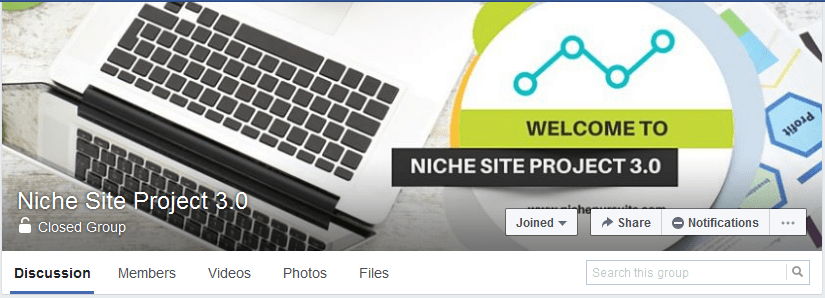How to Create a Facebook Group and Make it Thrive

When you buy something through one of the links on our site, we may earn an affiliate commission.
Spencer's Note: This is an article contributed by Valerie Johnston, and she has some great tips on how to create a facebook group, grow it, and make it a success.
I've personally seen tons of growth with my closed Facebook group for Niche Site Project 3. You can join that group right here to get a better idea of how I run it and to connect with others interested in building niche websites.
Valerie has some great tips, much of what I have applied to grow my private Facebook group to nearly 15,000 members.
While Facebook may not be growing as rapidly anymore compared to Snapchat, Instagram, or the next big social media brand right around the corner, there’s no denying that none of these sites offer anything quite like Facebook Groups. Groups remains one of the most popular features on Facebook, with over one billion active communities connecting members with content, products, and other people.
Learning how to create a Facebook Group for your business is a great way to help build a more loyal and engaged audience – but it takes more than just clicking “Create” to truly have a successful Group. In this guide, we’ll show you everything you need to do to not only set up your Group, but also to ensure that it thrives.
Facebook Pages vs. Groups, and Why You Need a Group
Many people are confused about the difference between a Facebook Group and a Facebook Page. Most businesses are prompted by Facebook to create a Page, and because this Page does provide your audiences a place to comment and engage, you may be wondering why you even need a Group.
The big difference is that a Group was designed to support community engagement, while a Page was designed to be a simple profile for your business or brand. Think of a Page as your website’s landing page, while your Group is more like a customer forum hosted on your website.
Setting Up Your Facebook Group
Learning how to create a Facebook Group is simple. Just click on “Add Group” from your home page, and then “Create New Group”. From there, you’ll go through a simple step-by-step process for setting up the new group, starting with a great name.

You can change the name of your Group later on, but it’s a good idea to do a bit of searching first. You want your Group to stand out, to be easy to find, and not easily confused with any existing Group. A good Group name tells people at a glance what your community is all about, and is engaging.
Search out Groups that are in your industry or niche, and compare the names of larger Groups with stagnant small Groups to get an idea of what excites your target audience.
Next you’ll need to add a member (someone other than yourself) to get the Group started. Choose a trusted friend or business partner, someone who knows what you’re up to.
Finally, choose your privacy setting. Open Groups are totally available to the public. Closed Groups allow the public to search out your Group and see the preliminaries, but only members can see the posts in the Group. Finally, secret Groups can’t be seen or searched out by anyone unless they are a member. There are many reasons to choose one or the other, but be sure to consider wisely from the start – closed or secret Groups can’t be opened after you reach more than 250 members.
Topics and Rules
Be sure to decide early on the parameters of your Group. What topics, specifically, do you want conversation to focus on? What rules do you want to set in place? For example, while it may be common sense to request that everyone stay civil, do you want to ban self-promotion in your Group? This might help members come around more often, if they are certain they won’t be bombarded with advertisements every time they show up.
Set clear expectations, and clear consequences, such as immediate post deletion, or removal from the Group, so that your Group members know what they can expect.
After you’ve taken care of those three things, you click “Create”, and your Group is live. You can choose an icon from Facebook’s selection of graphics, or skip that portion if you want.
You’ll also need to pick a good graphic to be your Group’s page banner. Make it easy to see but dynamic, similar to choosing any other social media avatar. You can also choose to let Facebook populate the banner area with random Group member avatars, which can be an interesting way to make the community feel more like a collective effort.

Complete your Group by adding information to the “About” section. This is a great place to announce any rules or guidelines, and to give your members an overview of what your Group topic is all about. Be sure to check out all of the settings that you can change, such as privacy settings, membership approval settings, and the Group URL. You can also set up a Group email address.
Your First Members
So now that you’ve gotten your Group set up, you need to focus on creating a thriving community. Before you start sending out links and invites to everyone and their uncle, take a second to consider the importance of your first members. The core voice of your Group will likely be shaped by these members, so it’s important to choose people who will not only create the type of community you want, but also people who will help you grow the Group even more.
Choose your initial members by hand and personally invite them. The should be dynamic Facebook users with large followings, who are experts or fan-favorites in your specific niche. This gives your Group the credibility it needs to attract new members in the future.
Create a Launch Event
It’s a great idea to consider creating a campaign before you ever create your Group. Make the Group launch an event; schedule a Q & A with an industry darling in your Group on day one, or find another way to make it special. Then build up anticipation by blogging, tweeting, or hinting at the Group’s unveiling during the weeks leading up to the launch. This is a good way to attract members who are truly interested in what you have to offer right off the bat.
Finally, another tried and true method for growing your initial member list is to offer an incentive for joining within the first week or month. The catch is that the incentive should be designed to attract people who will stick around to engage.
For example, offer a free eBook or exclusive video content to new members, with the guarantee that they’ll receive more exclusive content in the future. Or structure your incentive content so that new members receive it in parts over the span of a few days or weeks. This will at least keep them sticking around until they’ve received all of the free incentive, which gives them time to become interested in the community.
The goal for any Facebook Group is to get to 500 members as quickly as possible. At that point, the Group becomes much more visible in Facebook’s newsfeed, which will generate organic leads without you having to do a thing.
How To Grow After Initial Members Join
Now that you’ve got your initial group of carefully selected members, how do you leverage their involvement to grow even more? Of course, the first and most important thing that you always need to do is to keep supplying your Group with fresh, engaging, relevant content. Just like keeping a blog active and growing, it takes expertise in your field, plus an eye on the general trend of conversation.
Take advantage of questions or conversations raised by members by building your content around what your Group is interested in. Ask valued Group members to curate content once a month, or bring in guest curators from other Groups. If your content is always updating, your members will have a reason to check in frequently.
Advertise
Advertising the Group is usually the next step for most businesses, but for the most part, Facebook Group advertisements don’t have to be expensive or flashy. In fact, your best advertisement is probably going to be free. Posts to your audience on other social media websites can help interested consumers find a place to talk to you more in-depth. Let them know what they are missing out on with teaser posts of new content.
Partner
A great way to gain more exposure within Facebook is to partner up with other Groups. Arrange to guest curate in another Group of a related industry, and offer them a chance to do the same in your Group. You can also arrange to do a simple promo swap, where you find a way to mention their Group within yours, and they do the same for you.
Gather enough of these partnerships, and your Group name could be seen by thousands of potential new members every day. The key is to seek out Groups that are related to your community’s interests, so that you can always offer content that is relevant.
Keywords and Tags
If you aren’t seeing a lot of growth in your Facebook Group, consider tweaking the keywords and tags in your group description. You can tag your group with three unique keywords, shown under the description in “Group settings”, that will help searchers find you easily. So, if your brand is largely focused on entrepreneurs, you could choose tags such as “work at home”, “start up business”, and other popular keywords for your area.
Find a Co-admin
If you don’t have a large following yourself; it can be hard to get followers simply by posting to your own social media profiles. That’s why starting a Facebook Group is always better when you have a co-admin. Choose a friend or business colleague, someone whose vision lines up exactly with yours. Create a Group that serves both of your audiences, and then you can leverage each other’s following.
Loyalty Program
Be sure to create some sort of loyalty program that rewards existing members for inviting their friends. You could offer free services, such as life coaching or a review of their business plan, or free products, such as a copy of your book.
However, one interesting idea that won’t cost you a dime is to offer a self-promotion slot to a group member who can successfully invite a certain number of members who are still around and active after a month. This does several things: it gives small business owners major incentive, because they want your large crowd of interested members checking out their links; and it ensures that you don’t just get a deluge of silent members, joined only to help a friend win a contest.
Re-launch
When you launched your Group, you likely had a Facebook event listed, and you hopefully turned it into an exciting attraction with guests, fresh content, incentives, and build-up in the previous weeks (see our full guide to Facebook events manager for tips). It’s a good idea to continue doing “re-launches” of your Group on a regular basis, to continually invite new users who may not have been around when the first launch occurred. The same things you did to make your first launch so successful can be repeated every quarter, twice a year, or on whatever schedule works for your brand.
Use Your Facebook Page
Be sure that your main Facebook Page directs passers-by to your Group, especially if it is closed. Be sure to put up some sample content or a screenshot of a good conversation, to let interested parties know what they are missing by not being in your Group.
Keep Growing and Go Viral
If you are careful to launch your Group correctly, take the time to really solidify what your focus is, choose your initial members wisely, and keep your content consistently high-quality, chances are that your Group will grow exponentially almost on its own. As you can see, there are a lot of ways to leverage your connections in your industry, your audience, and your understanding of your target market, to create a thriving Facebook Group.
However, there are times when a Facebook advertisement may be a great way to get your Group in the public eye. Once you’ve got a solid community with consistently excellent quality, the final option should be to ramp up your advertising budget and let Facebook do the work for you. Just remember that everything listed in the article above should be part of an ongoing campaign to create the most dynamic Facebook community you can.
Overall, you now know how to create a Facebook group, and more importantly how to make it a thriving success.
But do Facebook Groups make money? We've got you covered.
Sources:
https://www.postplanner.com/how-to-create-a-facebook-group/
http://www.iandavidchapman.com/facebook-groups-10-steps-to-make-your-facebook-group-go-viral/
Want to learn step-by-step how I built my Niche Site Empire up to a full-time income?
Yes! I Love to Learn
Learn How I Built My Niche Site Empire to a Full-time Income
- How to Pick the Right Keywords at the START, and avoid the losers
- How to Scale and Outsource 90% of the Work, Allowing Your Empire to GROW Without You
- How to Build a Site That Gets REAL TRAFFIC FROM GOOGLE (every. single. day.)
- Subscribe to the Niche Pursuits Newsletter delivered with value 3X per week
My top recommendations

















8 Comments
Conversation
Sounds great but I am not clear on how you monetize this group. Maybe if you pump your own blog postings to the group you might get some traffic off of that.
Same here: I was wondering how the monetization scheme looks like when you have a FB group. Or maybe it is just for branding purpose.
thanks for sharing. Is using facebook groups for sharing my blog posts ?
Is this worthy?
Sure, that can work
Great tips Spencer! I was wondering, would it be okay to let the members share their content? wouldn’t that spam the group feed?
You can make each post by members require admin approval first. That way you can monitor what type and how much content gets through. I made a rule in my FB group that no one can post their own website/blog content.
Thanks for the tips Spencer 🙂
Thanks for the tips about facebook group. We think it easy to create but it really hard to maintain. I have some facebook group, but there was some problem. Like that, there was no activity without me like, post engagement, share, new member etc. I hope your tips make me perfect for maintain and growing my facebook group.